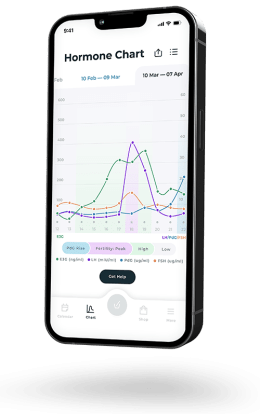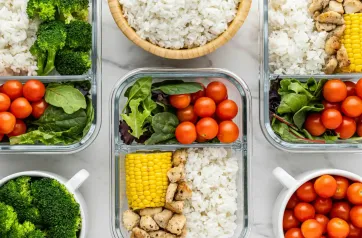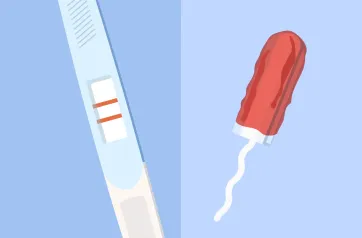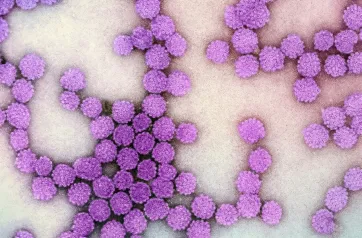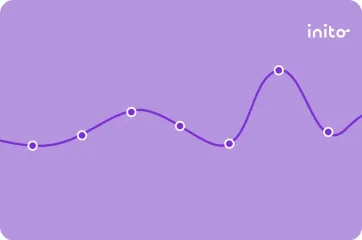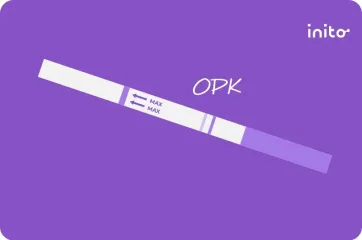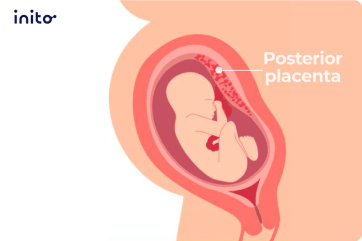Content table
Do you ever feel like your body’s a mystery? It’s easy to focus on the parts of the menstrual cycle that get the most attention, like your period and PMS, but what about your follicular phase?
This phase lasts from your period until ovulation, and it significantly impacts your energy, mood, and libido.
And if you’re trying to conceive, understanding your follicular phase isn’t just helpful — it’s a critical tool for identifying your fertile window.
Let’s explore this key part of your menstrual cycle. It’s time to shed light on what’s going on beneath the surface.
Key Takeaways
- The follicular phase marks the first part of your menstrual cycle. It starts with your period and ends with ovulation.
- The follicular phase length on average lasts between 12-18 days.
- The follicular phase includes early, mid, and late stages. Each has distinct hormonal activities.
- Early in the phase (during menstruation), you can expect symptoms like cramps, bloating, and mood swings.
- Later in the phase, you may feel increased energy, improved mood, and a heightened libido.
- The follicular phase is also marked by changes in your cervical mucus. It changes to an egg-white consistency near ovulation.
- Fuel your body with iron-rich foods during your bleed. And opt for estrogen-balancing foods later in the follicular phase.
- Adjust your exercise and activities to match your energy levels during different stages of the follicular phase.
What Exactly Is the Follicular Phase?
To understand the follicular phase, we first need to grasp the broader context of the menstrual cycle.
The menstrual cycle consists of distinct phases, each marked by hormonal events and physiological changes.
Your cycle gets simplified into three key menstrual cycle phases:
- Follicular phase
- Ovulation phase
- Luteal phase
The follicular phase begins with the first day of your period and ends with ovulation.
This unique phase can be further subdivided into:
- Early follicular phase
- Mid-follicular phase
- Late follicular phase
Here’s a deeper look at each.
1. Early follicular phase
At the start of your period, estrogen and progesterone are at their lowest point. This is also when the lining of the uterus sheds, causing bleeding.
During this time, the hypothalamus in your brain detects these low hormone levels. As a result, it begins to release Gonadotropin-Releasing Hormone (GnRH). GnRH acts like a messenger to the pituitary gland.
The pituitary gland (beneath the hypothalamus) responds to GnRH by releasing Follicle-Stimulating Hormone (FSH).
FSH is what stimulates the growth and recruitment of multiple follicles within your ovaries. Each follicle contains an immature egg. And so, the ovaries start to prep a number of follicles for ovulation. These follicles are like small sacs that hold the immature eggs.
2. Mid-follicular phase
As the follicles grow, one follicle typically becomes dominant, outgrowing the others. This dominant follicle is chosen to release the egg.
This dominant follicle also starts producing estrogen. Estrogen promotes the thickening of the inner uterine lining, a.k.a. the endometrium. This thickening preps the uterus for the potential implantation of a fertilized egg.
This mid-follicular phase is key to the development of the healthy, safe environment that’s needed for a potential pregnancy. This is the time your uterine lining becomes rich in blood vessels and nutrients. And this is why the follicular phase is sometimes called the proliferative phase.
3. Late follicular phase
As estrogen levels continue to rise, they trigger a negative feedback loop. This signals the pituitary gland to decrease FSH production.
The high levels of estrogen at this time also stimulate a surge in Luteinizing Hormone (LH) secretion from the pituitary gland. This surge in LH ultimately triggers ovulation — the release of the mature egg from the dominant follicle.
This surge is the key event that brings the follicular phase to its end and preps your body for the next phase.
Phase | What happens |
Early | All hormones are initially low – The hypothalamus starts producing GnRH, which causes the pituitary to release FSH. FSH is responsible for follicular growth and recruitment |
Mid | The follicle that grows the largest (dominant follicle) is selected – it starts producing estrogen.
This estrogen is also important for making the uterine lining thick and rich to prepare for a possible pregnancy (hence the follicular phase is also called the “proliferative phase” since the endometrial lining proliferates in response to estrogen. |
Late | As estrogen levels increase, it sends a signal to slow down FSH production and start secreting LH to trigger ovulation |
Know more: Trying to Get Pregnant? Get to Know Your Follicular Phase
What Are Follicular Phase Symptoms?
The hormonal fluctuations during your follicular phase manifest can physical and emotional symptoms.
In the menstrual phase (the first part of the follicular phase), low hormone levels can lead to period symptoms like:
Cramps
Prostaglandins are chemicals produced in the uterine lining. And they induce uterine contractions. These contractions are actually what help to shed your lining.
You’ll probably feel these contractions more intensely on the first day of your bleed. This is why cramping is often the worst at the start of your period or just before your period.
But it’s important to know that the intensity of cramps varies significantly from woman to woman. Some women experience very little discomfort while others experience severe pain.
Know more: Do Painful Periods Mean Good Fertility?
Bloating
Bloating is a very common experience during the follicular phase. The feeling of fullness in your abdomen is thanks to fluid retention and hormonal shifts, especially the drop in progesterone.
This bloating can cause discomfort and make your stomach feel tight.
Know more: Is Bloating During Ovulation Normal?
Nausea
Some women experience mild nausea during their period. This may be due to the effects of prostaglandins on the digestive system.
Nausea typically isn’t severe, but it can definitely be unpleasant.
Know more: Is Nausea During Ovulation Normal?
Breast tenderness
Fluctuating estrogen and progesterone levels can cause fluid retention in your breast tissue, causing them to become sensitive and tender.
Mood swings
The shift of hormones during the menstrual cycle is no joke. Fluctuating levels of estrogen and progesterone can seriously affect your emotions. You may feel irritable, sad, or anxious.
Researchers have also found that cortisol response to acute stressors varies throughout your cycle. They found that you’re more likely to handle stressful situations better in your follicular phase versus post-ovulation and leading up to your period.
So, if you’re noticing a big change in mood symptoms throughout your cycle, you may want to take a look at regulating your cortisol. This can help you maintain a more balanced mood overall.
We know that’s a lot to feel during this time of the month. But the good news is that all the above symptoms subside as you move through your follicular phase.
Know more: 4 Phases of Menstrual Cycle and Moods that Go With Each
As estrogen levels rise in the latter part of this phase, you might experience some more positive symptoms.
Increased energy levels
Estrogen is known to boost energy and vitality. So as you move through this time, you may feel more motivated and energized.
Talk about a welcome change after the fatigue of your menstrual phase!
Improved mood
Many women report a more positive mood once they move past their period. This optimism and happiness are likely due to the uptick in estrogen.
Increased sex drive
Estrogen isn’t just for boosting energy levels, mood, and vitality. It’s also shown to boost your libido. You may find yourself feeling more desire in the bedroom in the later part of your follicular phase.
That’s your body doing its natural thing as it’s prepping for potential conception and ovulation.
Know more: Is Having Sex Everyday Bad When Trying to Conceive?
Changes in cervical mucus
Right before ovulation, you’ll probably notice your cervical mucus change. It goes from sticky and thick to creamy, and then to a clear, stretchy consistency. It’s called egg-white cervical mucus or EWCM.
This change in consistency is thanks to rising estrogen levels. It helps make the mucus become
more hospitable to the sperm that your body is anticipating.
Know more: What Does Your Cervical Mucus Tell You About Your Body?
Tracking your follicular phase symptoms can be helpful when it comes to cycle awareness and fertility planning. With the Inito Fertility Monitor, you can track and confirm ovulation. This mentor helps you know exactly which phase of your cycle you’re in. You can also log your symptoms into the app and see correlations between them and your hormonal fluctuations.
Can You Get Pregnant During the Follicular Phase?
Yes! Conception is definitely possible during your follicular phase. In fact, your chances of getting pregnant are the highest on the day before ovulation.
The time of highest fertility is called the fertile window. And it includes the following:
- The four days before ovulation
- The day of ovulation
- The day after ovulation
So, engaging in sexual intercourse during this window of time increases the likelihood of pregnancy.
Know more: Getting pregnant: When are you most fertile?
Inito can help you ID your fertile window by tracking key fertility hormones:
- LH
- Estrogen
- FSH
What’s more, you can also confirm ovulation by tracking PdG (urine metabolite of progesterone) along with the above three hormones, all on a single test strip.
How Can You Support Your Body During the Follicular Phase?
Supporting your body in this phase involves adjusting your diet and your lifestyle.
Here’s how.
During menstruation
You want to focus on iron-rich foods to replenish the iron lost during bleeding.
Incorporate more of these foods into your diet at this time:
- Red meat
- Fortified cereals
- Leafy greens
- Seafood
You also want to give yourself plenty of energy-boosting foods to combat fatigue. This includes things like:
- Bananas
- Eggs
- Nuts
- Seeds
- Dark chocolate
And when it comes to movement, aim for gentle, low-impact, and low-intensity movements. Some of our favorites are:
- Yoga
- Walking
- Stretching
- Mat pilates
Mid- and late follicular phase
In this part of your cycle, you want to eat foods that support estrogen balance and help boost your energy levels. Things like:
- Flax seeds
- Legumes
- Fruits
- Vegetables
- Lean protein
- Avocados
Enjoy higher-intensity workouts like weightlifting and cardio at this time. Your body is better equipped to handle them.
This is also when inspiration tends to strike. So start some new projects and engage in social activities during the latter part of your follicular phase.
Know more: Cycle Syncing: What It Is and How to Start?

FAQs
During your period, focus on replenishing nutrients and supporting your body. Consider eating:
- Iron-rich foods (red meat, spinach, lentils)
- Foods rich in omega-3 fatty acids (salmon, flaxseeds)
- Warming and easily digestible foods (soups, stews)
- Fruits and vegetables for vitamins and minerals
As you move from your period to the later part of this phase, you want foods that support your rising estrogen and give you good energy. These include:
- Lean proteins (chicken, fish)
- Complex carbs (oatmeal, sweet potatoes)
- Healthy fats (avocados, nuts)
- Leafy greens
- Colorful veggies
- Phytoestrogens (soy or flaxseeds)
Absolutely! In fact, the day leading up to ovulation is when you’re most fertile.
Think of follicles as little sacs inside your ovaries. Each one holds an immature egg.
During the follicular phase, FSH gets these follicles to grow. One of them becomes the dominant follicle. And that’s the one that releases the mature egg during ovulation.
So follicles are like the egg’s home, getting it ready for its big moment.
This is different for everyone, but here is a general idea.
- During your period (early follicular): You might feel tired, crampy, and a bit moody.
- Moving into the latter part of follicular: You may notice your energy picking up, your mood improving, and maybe a boost in your sex drive.
- Ovulation: You will have the highest energy levels, sex drive, and confidence during this time.
- Luteal phase, after ovulation: You may feel some premenstrual syndrome (PMS) symptoms like bloating, mood swings, and food cravings.
The follicular phase is mixed. At the beginning, during your period, you might feel low-energy and uncomfortable.
But, as you move into the latter part of this phase, things start to get better. You might feel more energized, more positive, and more like yourself. It may feel like your body is starting to come out of hibernation!
Every woman’s body is a bit different. But you can expect the follicular phase length to be between 12 to 18 days.
Was this article helpful?
Life-Style and Reproductive Factors Associated with Follicular Phase Length
Proliferative and Follicular Phases of the Menstrual Cycle
Chapter 32 – Menstruation, normal cycle
The Normal Menstrual Cycle and the Control of Ovulation
Contractility of the nonpregnant uterus: the follicular phase
Psychiatric Symptoms Across the Menstrual Cycle in Adult Women: A Comprehensive Review
Estrogen as a key regulator of energy homeostasis and metabolic health








